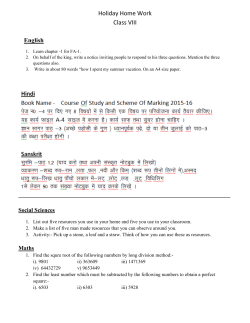
Coloring Graphs - Boise State University
Mathematical Puzzles Mac Stannard Stacia Orr Mathematical Puzzles A glimpse into the disconcertion of brilliance Instant Insanity Puzzle Introduction Graph theory Reaching an end game Rubik’s Magical Cube Mac Stannard Stacia Orr Department of Mathematics Boise State University April 2015 Group theory God’s number and the Devil’s algorithm For Reflection and Further Reading Intro to Instant Insanity Mathematical Puzzles Mac Stannard Stacia Orr Instant Insanity Puzzle Introduction Graph theory Reaching an end game • Created by Franz Owen Armbruster in 1967 • Goal: stack the cubes so that each color is seen exactly once on the front, back, left, and right • 41,472 possible arrangements Rubik’s Magical Cube Group theory God’s number and the Devil’s algorithm For Reflection and Further Reading Graph Theory Mathematical Puzzles Mac Stannard Stacia Orr • We can solve this using graph theory • Begin by mapping out the colors shown on each cube’s three opposite sides Instant Insanity Puzzle Introduction Graph theory Reaching an end game Rubik’s Magical Cube Group theory God’s number and the Devil’s algorithm For Reflection and Further Reading Solution Mathematical Puzzles Mac Stannard Stacia Orr Instant Insanity Puzzle • Break it into two separate graphs: 1. front/back 2. left/right • Three criteria must be met for these graphs: 1. each graph must contain one edge from each cube 2. no edges are in common 3. vertices cannot be greater than degree three Introduction Graph theory Reaching an end game Rubik’s Magical Cube Group theory God’s number and the Devil’s algorithm For Reflection and Further Reading Solution Mathematical Puzzles Mac Stannard Stacia Orr Instant Insanity Puzzle • Stack the cubes accordingly Introduction Graph theory Reaching an end game Rubik’s Magical Cube Group theory God’s number and the Devil’s algorithm For Reflection and Further Reading Group Theory Mathematical Puzzles The mathematical study of structure and symmetry Mac Stannard Stacia Orr Instant Insanity Puzzle Introduction Graph theory Reaching an end game Rubik’s Magical Cube • Permutation groups • Cayley’s graph Group theory God’s number and the Devil’s algorithm For Reflection and Further Reading Mathematical Puzzles Meet the cube Mac Stannard Stacia Orr Instant Insanity Puzzle • Cube anatomy ◦ faces and facelets ◦ cubies and cubicles Introduction Graph theory Reaching an end game 1. center 2. corner 3. edge Rubik’s Magical Cube Group theory God’s number and the Devil’s algorithm For Reflection and Further Reading • Movement ◦ F, B, L, R, U, D ◦ direction 8! × 37 × 12! 2 × 211 God’s number Mathematical Puzzles The winning strategy of omniscience Mac Stannard Stacia Orr Instant Insanity Puzzle • Fewest possible moves required to solve a Rubik’s cube • God’s algorithm • Holds for any arrangement • Correlation to Cayley’s graph • Presently known to be equal to 20 Introduction Graph theory Reaching an end game Rubik’s Magical Cube Group theory God’s number and the Devil’s algorithm For Reflection and Further Reading Mathematical Puzzles The Devil’s algorithm Mac Stannard Stacia Orr Instant Insanity Puzzle • A set of moves that will eventually restore a cube to its solved state • The Devil’s number is presently believed to be between 34,326,986,725,785,600 and 43,251,683,287,486,463,996 Introduction Graph theory Reaching an end game Rubik’s Magical Cube Group theory God’s number and the Devil’s algorithm For Reflection and Further Reading For reflection and procrastination Mathematical Puzzles Mac Stannard Stacia Orr Instant Insanity Puzzle Introduction Graph theory Reaching an end game • More puzzles ◦ ◦ ◦ ◦ 15 Puzzle Pyraminx Rainbow Masterball Superflip Rubik’s Magical Cube Group theory God’s number and the Devil’s algorithm For Reflection and Further Reading For further reading Mathematical Puzzles Mac Stannard Stacia Orr Instant Insanity Puzzle David Joyner. Adventures in Group Theory. The John Hopkins University Press, 2008. Alexander H. Frey, Jr. and David Singmaster. Handbook of Cubik Math. Enslow Publishers, Inc., 1982. M. Conrady and M. Dunivan. The Cross Group of the Rubik’s Cube. U.S. Naval Academy, 1997. http://www.permutationpuzzles.org/rubik/crossgp.html Introduction Graph theory Reaching an end game Rubik’s Magical Cube Group theory God’s number and the Devil’s algorithm For Reflection and Further Reading
© Copyright 2025









